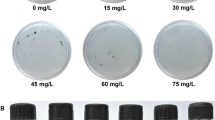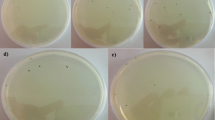Abstract
Recently, microalgae have attracted much attention as a new bioreactor system for producing high-value heterologous proteins. In this paper, we investigated the expression of soybean Kunitz trypsin inhibitor gene SKTI in the chlorophyte Dunaliella salina. Using D. salina genomic DNA as template, the entire coding region of SKTI was amplified by PCR as a 654-bp DNA fragment. It had 100 % identity with the published sequence of SKTI. The entire SKTI fragment was cloned into the expression vector pCAM2201 at a site just downstream of 35S promoter of to yield pCAMSKTI. D. salina cells transfected with pCAMSKTI by means of the lithium acetate/polyethylene glycol-mediated method expressed a protein of 20.1 kDa as detected by anti-SKTI antibody. In addition, SDS-PAGE analysis of the cell extract also revealed an intense protein band indicative of the recombinant SKTI. SKTI was therefore successfully expressed in D. salina, and the expression could be detected for at least 35 generations.




Similar content being viewed by others
References
Bradford MM (1976) A rapid and sensitive method for the quantitation of microgram quantities of protein utilizing the principle of protein dye binding. Anal Biochem 72:248–254
Cabanes-Macheteau M, Fitchette-Laine AC, Loutelie-Bourhis C, Lange C, Vine N, Ma J, Lerouge P, Faye L (1999) N-Glycosylation of a mouse IgG expressed in transgenic tobacco plants. Glycobiology 9:365–372
Chen MY (1995) Biological food culture. China Agriculture, Beijing, pp 62–63, (In Chinese)
Cramer CL, Boothe JG, Oishi KK (1999) Transgenic plants for therapeutic proteins: linking upstream and downstream strategies. Curr Top Microbiol Immunol 240:95–118
El-Sheekh MM (1999) Stable transformation of the intact cells of Chlorella kessleri with high velocity microprojectiles. Biol Plantarum 42:209–216
Falco MC, Silva-Filho MC (2003) Expression of soybean proteinase inhibitors in transgenic sugarcane plants: effects on natural defense against Diatraea saccharalis. Plant Physiol Biochem 41:761–766
Feng SY, Jia YL, Liu HT et al (2007) Transformation of Dunaliella salina by using glass beads—a novel transformation method. Chin J Biotechnol 23(2):358–362 (In Chinese)
Fitzpatrick KL, Tyerman SD, Kaiser BN (2008) Molybdate transport through the plant sulfate transporter SHST1. FEBS Lett 582:1508–1513
Franco OL, Dias SC, Magalhães CP, Monteiro ACS, Jr Bloch C, Melo FR, Oliveira-Neto OB, Monnerat RG, Grossi-de-Sá MF (2004) Effects of soybean Kunitz trypsin inhibitor on the cotton boll weevil (Anthonomus grandis). Phytochemistry 65:81–89
Franklin SE, Mayfield SP (2004) Prospects for molecular farming in the green alga Chlamydomonas. Curr Opin Plant Biol 7:159–165
Geng DG, Wang YQ, Li WB et al (2002) Transient expression of GUS gene in Dunaliella salina. High Technol Lett 12:35–39 (In Chinese)
Geng D, Wang Y, Wang P, Li W, Sun Y (2003) Stable expression of hepatitis B surface antigen in Dunaliella salina (Chlorophyta). J Appl Phycol 15:451–456
Gietz RD, Woods RA (2001) Genetic transformation of yeast. Biotechniques 30:816–831
Harlow E, Lane D (1999) Using antibodies: a laboratory manual. Cold Spring Harbor Laboratory Press
He Q (2003) Microalgae as platforms for recombinant proteins. In: Richmond A (ed) Handbook of microalgal culture: biotechnology and applied phycology. Blackwell, Oxford, pp 471–484
Hsieh CC, Hernández-Ledema B, Jeong HJ, Park JH, de Lumen BO (2010) Complementary roles in cancer prevention: protease inhibitor makes the cancer preventive peptide lunasin bioavailable. PLoS One 5(1):e8890
Kindle KL (1990) High-frequency nuclear transformation of Chlamydomonas reinhardtii. Proc Natl Acad Sci U S A 87:1228–1232
Kobayashi H, Suzuki M, Kanayama N, Terao T (2004) A soybean Kunitz trypsin inhibitor suppresses ovarian cancer cell invasion by blocking urokinase upregulation. Clin Exp Metastasis 21:159–166
Koide T, Tsunasawa S, Ikenaka T (1993) Studies on soybean trypsin inhibitors and amino acid sequence around the reactive site of soybean trypsin inhibitor (Kunitz). Eur J Biochem 32:408–416
Li J, Yan HX, Qu DJ (2007) Construction of an EGFP eukaryotic expression vector by SOEing and its transformation to Dunaliella Salina. Acta Hydrobiol Sin 31(4):546–551 (In Chinese)
Li J, Brader G, Palva ET (2008) Kunitz trypsin inhibitor: an antagonist of cell death triggered by phytopathogens and fumonisin B1 in arabidopsis. Mol Plant 1:482–495
Lippman SM, Matrisian LM (2000) Protease inhibitors in oral carcinogenesis and chemoprevention. Clin Cancer Res 6:4599–4603
Lv YM, Xie H, Niu XL et al (2002) Transfer of bar gene to Dunaliella salina by microprojectile delivery and detection of transgenic alga. J Zhengzhou Univ 12(2):35–39 (In Chinese)
Paju A, Hotakainen K, Cao Y, Laurila T, Gadaleanu V, Hemminki A, Stenman U, Bjartell A (2007) Increased expression of tumor-associated trypsin inhibitor, TATI, in prostate cancer and in androgen-independent 22Rv1 cells. Eur Urol 52:1670–1681
Rashed NA, Macdonald MH, Matthews BF (2008) Protease inhibitor expression in soybean roots exhibiting susceptible and resistant interactions with soybean cyst nematode. J Nematol 40:138–146
Ribeiro JK, Cunha DD, Fook JM, Sales MP (2010) New properties of the soybean trypsin inhibitor: inhibition of human neutrophil elastase and its effect on acute pulmonary injury. Eur J Pharmacol 644:238–244
Sala F, Manuela Rigano M, Barbante A, Basso B, Walmsley AM, Castiglione S (2003) Vaccine antigen production in transgenic plants: strategies, gene constructs and perspectives. Vaccine 21:803–808
Sambrook J, Fritsch EF, Maniatis T (1989) Molecular cloning: a laboratory manual. Cold Spring Harbor Laboratory Press
Song SI, Kim CH, Baek SJ, Choi YD (1993) Nucleotide sequences of cDNAs encoding the precursors for soybean (Glycine max). Plant Physiol 101:1401–1402
Walker TL, Purton S, Becker DK, Collet C (2005) Microalgae as bioreactors. Plant Cell Rep 24:629–641
Acknowledgments
This research was supported by the National Natural Science Funds of China (grant no. 30972240) and Project of Education Department of Liaoning Province of China (no. 2008T023). The authors thank Dr Alan K Chang for his contribution in the revision of the manuscript.
Author information
Authors and Affiliations
Corresponding author
Rights and permissions
About this article
Cite this article
Chai, XJ., Chen, HX., Xu, WQ. et al. Expression of soybean Kunitz trypsin inhibitor gene SKTI in Dunaliella salina . J Appl Phycol 25, 139–144 (2013). https://doi.org/10.1007/s10811-012-9847-8
Received:
Revised:
Accepted:
Published:
Issue Date:
DOI: https://doi.org/10.1007/s10811-012-9847-8




